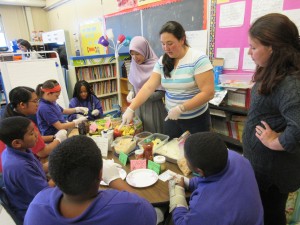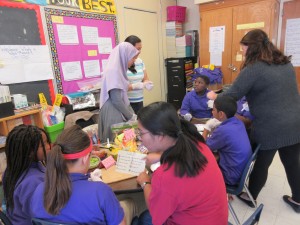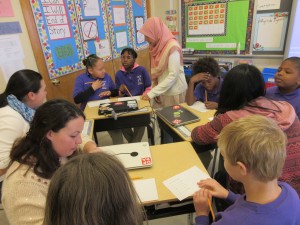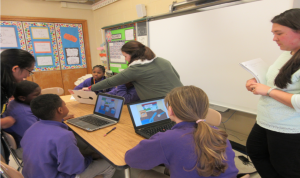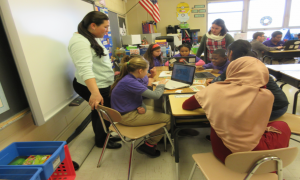School 2 Visits
Nov 29th, 2015 by kanaik
First Visit: Food Interaction
Thursday, October 15th 2015
We brought food for the students and made them “create” a dish that would be balanced for the persona that each group picked. The students enjoyed this as they made a snack for themselves and learned about nutrition. After completing his/her dish, each student had to make an advertisement for the dish and explain the nutritional benefits of the dish. This reinforced the choices they made for their dish. The timing of this worked out well as they were starting to learn about the human body in their biology class.
The following is a list of personas/ scenarios the students were prompted with
- Dante plays basketball for the Troy HS team. He loves to hang out at your restaurant after practice. What dish would make him feel refreshed?
- Bartholomew and his family come into your restaurant every Thursday for dinner. Bartholomew’s dad wants to improve his cholesterol, by having less greasy food.
- Grandma and Grandpa like to read the newspaper at your restaurant, but have been having difficulty reading the small font, and they constantly complain that their bones ache.
- Mimi is diabetic and has low blood sugar, so she came to your restaurant for late lunch. She’s feeling lightheaded so what should you feed her?
- Martha wants a dessert to end her day on a happy note.
- D’mitri is a kindergartener who just started school. He’s a growing boy!
- Shanika is recovering from being sick. What food will make her make feel better?
- Jacob just found out he has problems with his muscles and how they use oxygen. What type of dish could you make to help him?
Second Visit: Recipe Ratios Game V1
Monday, November 9th 2015
This was a spin off of the food. We learned from our first game that students enjoyed the food. We wanted to keep that interaction but also incorporate more “learning”/academic background into our project. We decided that math is an important area as students are constantly tested on different math concepts. Along with the video game, we created a worksheet to have the students complete the math section first then play the game. This was done because we did not have failure mechanisms implemented at the time.
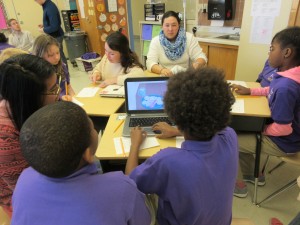
Students playing the and giving us feedback as they play through the game.
The following is a list of Feedback from the students:
- It was hard to use the track pad to scoop up the ingredients in the game
- Wanted to see different kinds of food recipes besides sugar cookies
- Wanted to have a virtual checklist on the side of the screen
- Wanted to have more control over the placement of ingredients (spreading of frosting ect.)
Third Visit: Recipe Ratios Game V2
Thursday, December 10th 2015
After we tested the first version of the game, we learned that the students didn’t have the skills necessary to complete the game on their own. We decided that we need to incorporate more basic fractions and math concepts into the game. We also received feedback about the subject matter of the game, and altered our game to focus on making pizza as opposed to cake. Additionally, failure mechanisms and hints were coded into the game so that students were actually completing math problems.
The most recent iteration of the game was received with great enthusiasm. Most of the students were very proactive about memorizing the recipe that was given, or even writing it down. Most were very successful and completed the math portions of the game without any assistance. In particular, the interactive pizza tossing portion of the game garnered the most enthusiastic response, with many of the students playing through the game repeatedly just to be able to “toss” their pizza dough.
Based on observations, the following conclusions were made about the future iterations of our game:
- More levels are needed
- The math problems need to be restructured. After playing more than once, the students essentially memorized the answers and no longer put any thought into working through the problems, which defeats the purpose of the game.
- There needs to be more interactivity to keep students engaged throughout the game, instead of just during one specific portion of the game.
- One student commented how she would like to go to the store and buy the ingredients. This would create a connection between our first visit with the food and the the video game with a virtual reality.
